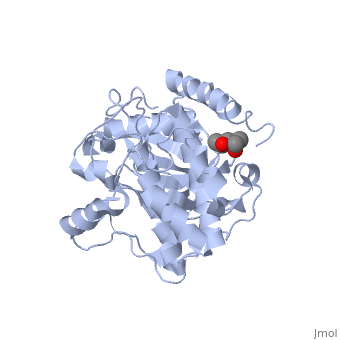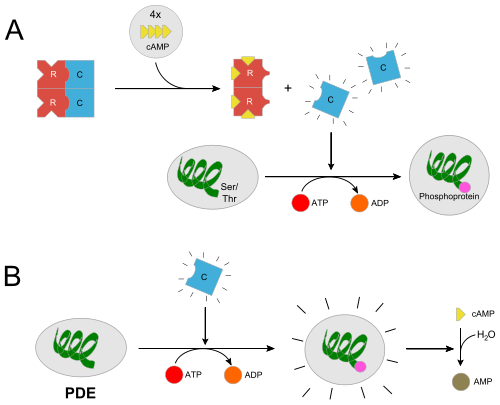CAMP Dependent Protein Kinase, Catalytic Subunit
From Proteopedia
Contents |
Introduction
The catalytic subunit of PKA is model kinase that is very well characterized because of its catalytic and structural simplicity and ease of Isolation. PKA is essential to cellular signalling in eukaryotes and is involved in a myriad of different processes depending on cell type. PKA catalyzes the transfer of a gamma-phosphoryl group of a molecule of ATP to either a serine or threonine residue on the target protein. This post-translational modification can serve to alter the function of the phosphorylated target protein.
General Domain Structure
The catallytic subunit of PKA consists of a that is characteristic of many kinases throughout nature. The upper N-terminal lobe of the kinase is dominated by beta-sheet architecture while the lower, larger C-term is mostly alpha helical. Located in between the two lobes is the
Activation and Interaction with Regulatory Subunit
|
In the inactive state, the catalytic subunit of PKA exists as a heterotetramer with two regulatory subunits and two catalytic subunits. Regulatory subunits often interact with A Kinase Anchoring proteins that serve to localize a population of PKA in a certain cellular environment, priming a particular response. Upon, cAMP binding to the regulatory domain of PKA (two molecules of cAMP per regulatory subunit) the catalytic subunit is released from the holoenzyme complex and is free to diffuse and exhibit its catalytic activity. Two of the most important residues for this docking interaction are and which both sit in the nucleotide binding region (Phosphate Binding Cassette) of the regulatory subunit. In essence, when a cAMP molecule binds to these trp and tyr binding sites, the docking interaction is ablated. This shows a different representation.[1]
References
- ↑ Kim C, Cheng CY, Saldanha SA, Taylor SS. PKA-I holoenzyme structure reveals a mechanism for cAMP-dependent activation. Cell. 2007 Sep 21;130(6):1032-43. PMID:17889648 doi:10.1016/j.cell.2007.07.018




